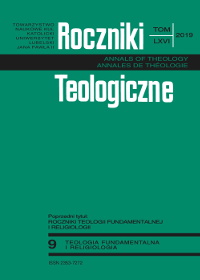Lived Religion
Abstract
The article presents the concept of a lived religion, which corresponds to modern forms of experiencing the sacred. Postmodernity emphasizes religious experience, often individual, apart from institutionalization of churches. The concept of a lived religion complies with new forms of the sacred stressing, among others, the meaning of embodiment, discourse, materiality and sensational forms in religious experiences. The concept of a lived religion focuses on a person practicing religion, however, ignoring the issues of transcendence, truth and supernatural effects.
References
Ammerman, Nancy T. (2016). „Lived Religion as an Emerging Field. An Assessment of Its Contours and Frontiers”. Nordic Journal of Religion and Society, 29(2), 83-99. Https://hdl. handle.net/2144/19161 (dostęp: 3.01.2019).
Bastide, Roger (1975). „Le sacré sauvage”. W: Tenże. Le sacré sauvage et autres essais (s. 214-236). Paris: Payot. Tłum. polskie Jacek J. Pawlik, „Dzika świętość”. Konteksty. Polska Sztuka Ludowa, 62(2008), 1:23-31.
Berger, Peter L. (2005). Święty baldachim. Elementy socjologicznej teorii religii. Kraków: Zakład Wydawniczy NOMOS. Pierwodruk 1967.
Bourdieu, Pierre (2007). Szkic teorii praktyki poprzedzony trzema studiami na temat etnologii Kabylów. Kęty: Wyd. Marek Drzewiecki. Pierwodruk 1972.
Csordas, Thomas J. (1990). „Embodiment as a Paradigm for Anthropology”. Ethnos, 18/1, 5-47.
Tenże (1994). „Introduction. The Body as representation and being-in-the-world”. W: Embodiment and experience. The Existential ground of culture and self. Red. Thomas J. Csordas (s. 1-24). Cambridge: Cambridge University Press.
Geurts, Kathryn Linn (2008). „O kamieniu, chodzeniu i mówieniu w Afryce Zachodniej. Kategorie kulturowe i antropologia zmysłów”. W: Estetyka Afryki. Antologia. Red. Małgorzata Cymorek (s. 5-26). Kraków: Universitas.
Hall, David (1997). „Introduction”. W: Lived Religion in America. Toward a History of Practice. Red. David Hall (s. VII-XIII). Princeton: Princeton University Press.
Hobart, Angela, Kapferer, Bruce (2005). „Introduction. The Aesthetics of Symbolic Construction and Experience”. W: Aesthetics in Performance. Formations of Symbolic Construction and Experience. Red. Angela Hobart, Bruce Kapferer (s. 1-22). New York: Berghahn Books.
Jeffrey, Denis (1998). Jouissance du sacré. Religion et postmodernité. Paris: Armand Colin.
Luckmann, Thomas (2012). Niewidzialna religia. Problem religii w nowoczesnym społeczeństwie. Kraków: Zakład Wydawniczy NOMOS.
Mariański, Janusz (2013). Sekularyzacja. Desekularyzacja. Nowa duchowość. Studium socjologiczne. Kraków: Zakład Wydawniczy NOMOS.
Maurier, Henri (1997). La religion spontanée. Philosophie des religions traditionnelles d'Afrique noire. Paris: L'Harmattan.
Merleau-Pponty, Maurice (2001). Fenomenologia percepcji. Warszawa: Aletheia. Pierwodruk 1945.
Meyer, Birgit (2009). „Introduction. From Imagined Communities to Aesthetic Formations: Religious Mediations, Sensational Forms, and Styles of Binding”. W: Aesthetic Formations. Media, Religion, and the Senses. Red. Birgit Meyer (s. 1-28). New York: Palgrave Macmillan.
Niedźwiedź, Anna (2015). Religia przeżywana. Katolicyzm i jego konteksty we współczesnej Ghanie. Kraków: Wyd. Libron.
Piette, Albert (2003). Le fait religieux. Une théorie de la religion ordinaire. Paris: Economica.
Piette, Albert (2015). „Fakt religijny. Zwyczajna teoria religii”. Przeł. Jacek J. Pawlik. Forum Teologiczne, 16, 223-245.
Sulima, Roch (2017). „`Upadek' w codzienność”. Konteksty. Polska Sztuka Ludowa, 71, (1-2): 6-9.
Turner, Victor W. (2011). „Dewey, Dilthey i gra społeczna: szkic z zakresu antropologii doświadczenia”. W: Antropologia doświadczenia. Red. Victor W. Turner, Edward M. Bruner (s. 43-54). Kraków: Wyd. UJ. Pierwodruk 1986.
Williams, Raymond (1958). Culture and Society. London: Chatto and Windus.www.livedthe ologiy.org/overview/ (dostęp: 24.01.2019).
Copyright (c) 2019 Roczniki Teologiczne

This work is licensed under a Creative Commons Attribution-NonCommercial-NoDerivatives 4.0 International License.





